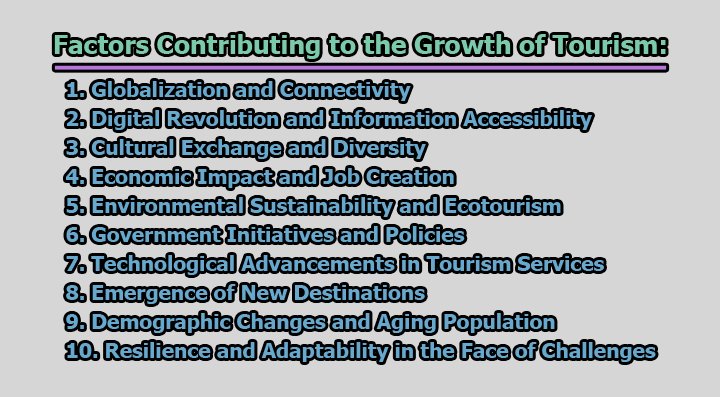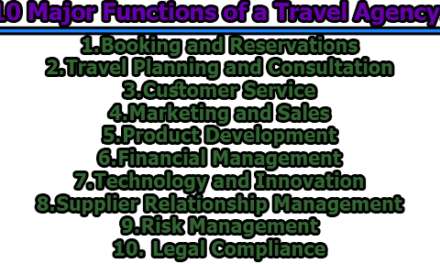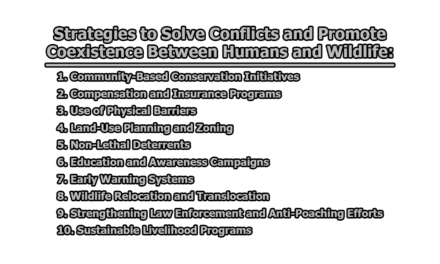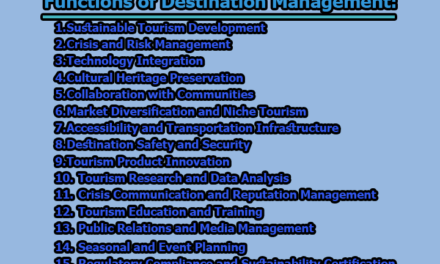Factors Contributing to the Growth of Tourism:
Tourism, a dynamic and multifaceted industry, stands as a testament to the human desire for exploration and cultural exchange. Over the years, it has evolved into a powerhouse of economic growth, cultural enrichment, and international cooperation. In this article, we will delve into the intricate tapestry of factors contributing to the growth of tourism, unraveling the essential elements that propel this industry forward.
1. Globalization and Connectivity: Globalization, characterized by increased interconnectedness and interdependence, has revolutionized the tourism landscape. The ease of international travel is a testament to this phenomenon, with advancements in transportation infrastructure playing a pivotal role. The ubiquity of air travel, efficient railway networks, and the development of modern highways have significantly reduced travel times and costs.
As the world becomes more accessible, tourists can explore distant and exotic destinations with unprecedented ease. This newfound connectivity not only expands the horizons of travelers but also promotes cross-cultural interactions. The ability to traverse borders effortlessly fosters a sense of unity among diverse societies, making tourism a catalyst for global understanding and cooperation.
2. Digital Revolution and Information Accessibility: The digital revolution has ushered in an era where information is at our fingertips, profoundly impacting the way individuals plan and experience travel. Social media platforms, travel websites, and online forums have democratized information, empowering potential tourists to make well-informed decisions.
Travelers today can access a wealth of information, ranging from destination reviews and accommodation options to local insights and cultural nuances. This democratization of information not only enhances the traveler’s autonomy but also compels destinations to showcase their unique offerings accurately. As a result, the digital age has transformed tourism into a more transparent and consumer-driven industry.
3. Cultural Exchange and Diversity: At its core, tourism is a vehicle for cultural exchange, fostering an appreciation for the diversity that defines our global community. Travelers are increasingly drawn to destinations that celebrate and preserve their cultural heritage, seeking authentic experiences that go beyond typical tourist attractions.
Communities that embrace and showcase their unique traditions, art, and cuisine become magnets for culturally curious travelers. As a consequence, tourism becomes a conduit for the preservation and promotion of cultural diversity, enriching both the traveler and the host community.
4. Economic Impact and Job Creation: The economic significance of tourism cannot be overstated. As a substantial contributor to the GDP of many nations, tourism serves as a vital economic engine. Beyond direct financial contributions, the industry plays a pivotal role in job creation across various sectors.
Hospitality, transportation, entertainment, and a myriad of ancillary services thrive in tourism-dependent regions. Local economies benefit from the influx of tourist spending, creating employment opportunities and driving economic growth. The cyclical nature of tourism-related income ensures a continuous flow of resources that can be reinvested into infrastructure and community development.
5. Environmental Sustainability and Ecotourism: In an era marked by growing environmental consciousness, sustainable tourism practices have emerged as a crucial consideration for both travelers and destinations. Modern tourists are increasingly mindful of their impact on the environment and seek destinations committed to ecotourism principles.
The rise of eco-friendly accommodations, responsible wildlife tourism, and initiatives to preserve natural habitats reflects a broader shift towards sustainable practices. Destinations that prioritize environmental conservation not only attract eco-conscious travelers but also contribute to the global effort to protect our planet for future generations. This intersection of tourism and environmental stewardship highlights the industry’s capacity to drive positive change and promote responsible travel.
6. Government Initiatives and Policies: Governments play a pivotal role in shaping the tourism landscape through strategic initiatives and policies. Proactive governmental involvement can significantly impact a destination’s attractiveness to tourists. Investments in infrastructure, such as airports, roads, and public transportation, enhance accessibility and overall visitor experience.
Moreover, tourism-friendly regulations and policies contribute to a conducive environment for the industry to flourish. Governments that prioritize marketing campaigns to promote their destinations on a global scale can create a positive perception, attracting a steady influx of tourists. By fostering an environment conducive to tourism development, governments become instrumental in harnessing the economic and social benefits associated with a thriving tourism sector.
7. Technological Advancements in Tourism Services: The integration of technology has revolutionized the way tourism services are delivered, enhancing the overall travel experience. Online booking platforms streamline reservation processes for accommodations, flights, and activities. Augmented reality (AR) and virtual reality (VR) technologies provide immersive previews of destinations, allowing travelers to virtually explore before making decisions.
Additionally, advancements in communication technologies ensure that tourists can stay connected with ease while exploring new destinations. Mobile apps offer real-time information, navigation assistance, and personalized recommendations, contributing to a seamless and efficient travel experience. The tourism industry’s ability to embrace and leverage these technological innovations reflects its adaptability to the evolving needs of modern travelers.
8. Emergence of New Destinations: As traditional tourist destinations become saturated, there is a growing trend towards exploring new and off-the-beaten-path locations. Travelers seek unique experiences and a sense of discovery, leading to the emergence of lesser-known destinations. This shift diversifies the tourism landscape, distributing economic benefits to regions that may have previously been overlooked.
The appeal of new destinations often lies in their authenticity, unspoiled natural beauty, and distinctive cultural offerings. Tourism boards and local communities can harness this trend by strategically promoting their unique attributes, attracting a wave of adventurous travelers eager to explore beyond conventional tourist hubs.
9. Demographic Changes and Aging Population: Demographic shifts, including an aging population with increased leisure time and disposable income, contribute significantly to the growth of tourism. Older individuals, often referred to as “silver travelers,” are increasingly becoming a prominent demographic in the tourism market. With a desire for leisure and cultural experiences, this group presents unique opportunities for the industry.
Accommodations, services, and travel packages tailored to the needs and preferences of seniors are on the rise. Destinations that actively cater to this demographic, offering accessibility and amenities that enhance the travel experience for older individuals, stand to benefit from the economic contributions and cultural enrichment brought about by this segment of the population.
10. Resilience and Adaptability in the Face of Challenges: The tourism industry’s ability to withstand and recover from challenges is a testament to its resilience. Natural disasters, pandemics, political unrest, and economic fluctuations are among the myriad challenges that the industry faces. However, the adaptability demonstrated by tourism stakeholders, including businesses, destinations, and policymakers, is crucial in navigating these uncertainties.
In the face of adversity, innovative solutions emerge. Crisis management plans, enhanced safety protocols, and technological advancements that support remote and virtual tourism experiences are examples of the industry’s resilience. By learning from challenges and proactively adapting, the tourism sector not only survives but evolves, ensuring its continued growth and contribution to global economies.
In conclusion, the growth of the tourism industry is a complex interplay of various factors, each weaving its thread into the vibrant tapestry of global travel. From the transformative impact of globalization to the emergence of sustainable practices, the tourism landscape is dynamic and ever-evolving. As we navigate the future of tourism, understanding these ten pillars provides insight into the forces propelling this industry forward. In embracing the opportunities and challenges that lie ahead, stakeholders can contribute to a sustainable and enriching future for global tourism.

Library Lecturer at Nurul Amin Degree College










